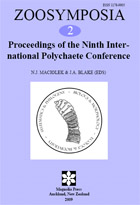Abstract
Capitella capitata (Fabricius, 1780), the type species of the genus, was originally described from the SW coast of Greenland; however, current definitions of the species are largely based on Eisig (1887), who described specimens from Naples on the Mediterranean coast. Eisig’s excellent account of the morphology of a sexually dimorphic species has subsequently been applied to specimens collected from worldwide locations. C. capitata was considered cosmopolitan in its distribution until J.P. Grassle and others identified numerous sibling species in laboratory culture. A large collection of Capitella from locations along the W, SW, and SE coasts of Greenland was provided by the Zoological Museum, University of Copenhagen (ZMUC). The collections included about 680 specimens with distinctive prostomial, thoracic, and setal morphology that differs from the typical depiction of the species in most faunal accounts. A neotype was selected from an excellent collection of approximately 250 specimens from Mârmorilik on the Affarlikassâ Fjord on the inner Uummannaq Fjord system, north of Disko Bay. All available collections from the ZMUC are believed to belong to the same species, which is here considered to be Arctic and subarctic in distribution. Additional material from the Alaskan Arctic supports this hypothesis. The Greenland species has a short, cup-shaped, wider-than-long prostomium joined to a narrow peristomial ring that is retracted slightly into setiger 1. In most specimens, the first four thoracic setigers gradually increase in size, with setiger 4 being the largest thoracic segment, and then decrease over the next five setigers, with setiger 9 being smaller than subsequent anterior abdominal segments. The thoracic region is thus markedly distinct visually from the abdominal region. Setigers 8–9 typically lack fascicles of notosetae, but 80% of the specimens examined have genital spines and most have copulatory organs that are secretory in nature: they contain numerous small secretion granules but no sperm. Many of these specimens have eggs and larvae within their tubes, suggesting functional hermaphroditism. The present redescription of C. capitata serves to establish a baseline against which the many known but undescribed species can be compared. Previous accounts of C. capitata based on the Eisig concept and largely from boreal and temperate localities should be reevaluated.

